Rupert Matthews's Blog, page 5
October 28, 2020
Poison Gas at Ypres 1915

The charming Flemish town of Ypres has a name that is pronounced in classical French as “eepre”, but in the local Flemish dialect as “weepres”. Thus the British officers called the place “eepre” when talking to the French high command, but the British tommies who mixed with the locals anglicised the Flemish pronunciation to be “wipers”. Very soon the town would be better known as “Bloody Wipers” due to the horrific battles that took place around the town.
When the winter closed down operations for 1914, Ypres was held by the British. The front line ran in a great bulge east of the town with the British lines pushing miles to the east into territory captured by the Germans. As soon as the good weather returned in the spring of 1915, the Germans launched an assault designed to eradicate the salient and bring Ypres into German hands. The resulting battle is generally known as Second Ypres, but the Battle Honour is Ypres 1915.
At 5pm on 22 April, the Germans released vast clouds of poisonous chlorine gas to be blown west toward the Allied lines. The gas struck a section held by French troops, and within less than ten minutes about 6,000 Frenchmen were dead. The survivors fled back to Ypres, bringing horrific tales of a deadly mist that spread silently to kill without mercy. A Canadian officer recognised the chlorine for what it was and knew that ammonia would block the gas. He therefore ordered his men to urinate into their handkerchiefs and breathe air through the soaked fabric.
Meanwhile, the Germans had advanced behind the gas to find the French lines utterly deserted. The German high command had not expected such success and did not have any reserves ready to break through, capture Ypres and surge on to spread havoc behind Allied lines. Instead the Germans occupied the abandoned French positions. The Canadians pushed gingerly forward and recaptured some of the lost trenches, elsewhere digging in to form a new front line.
On 25 April the Germans released more gas at the Canadians, and this time followed it up with a massed infantry assault. The Canadians fought well, but in places were pushed back. The Hampshires were sent forward to plug the gaps and to stop the Germans advancing around the village of St. Julien. The Germans were halted. Next day the Hampshires attacked again and this time managed to push the Germans back, but not so far as to the original front line. Local assaults continued around St Julien until 5 May after which the fighting died down. The Battle Honour St Julien is not carried on the colours.
Meanwhile, the Germans were planning quite different tactics for a third assault a few miles to the south at Frezenberg. The British trenches ran along the eastern side of a low ridge and at dawn on 8 May these trenches were deluged with heavy fire from German artillery. As soon as the heavy guns ceased firing, a wave of German infantry dashed forward to seize the shattered British positions. The artillery had not been as effective as the Germans had hoped and enough British riflemen opened fire to force the Germans to take cover. More German troops were pushed foward in renewed attacks and at 11am the 83rd and 84th Brigades were driven out of their trenches and fell back over the ridge to the low ground beyond. The gap was plugged by the 10th and 11th Brigades (of which the Hampshires formed a part) that night and new trench lines were hastily dug under German fire about 1.3 miles west of the ridge. The Battle Honour Frezenbergis not carried on the colours.
The fighting at Frezenberg continued until 13 May, but the front line did not move far from that established by the Hampshires on the night of 8 May.
The Germans were not yet finished with Ypres, however. On 24 May the Germans released another gas attack followed by infantry assaults at Bellewaarde south of the Frezenberg Ridge. The aim was to push back a small British salient formed by the German advance at Frezenberg. The attack was successful in driving the British back about 1,000 yards. The Germans halted the attacks after 24 hours, having achieved their objectives. The Battle Honour Bellewaarde is not carried on the colours.

Archimedes
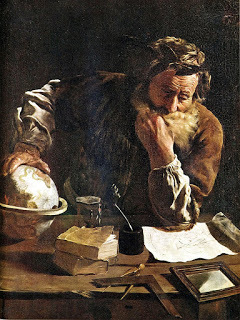
The great Greek scholar, scientist and inventor Archimedes of Syracuse (c.287bc-211bc) is best known today for his scientific works, but in his lifetime he was much more admired as an inventor of the most deadly weapons of his age.
Archimedes was born in Syracuse, then a wealthy Greek colony on the island of Sicily, to a noble family that was probably related to the kings of the city. As a young man he travelled to Alexandria in Egypt, then the centre of intellectual activity in the Greek world and site of the famous Library of Alexandria - the largest in the world. At Alexandria, Archimedes won great fame for working out how to calculate the volume of a cone - something that had so far eluded even the finest mathematicians. He went on to develop what became known as the Archimedes Screw, a simple pumping device. The screw consists of an open-ended cylinder containing a tightly fitting spiral connected to a handle. If the bottom of the cylinder is placed in water at an angle and the spiral turned with the handle, water will be trapped in the threads of the spiral and pulled up to the top of the cylinder. This makes a much more effective pump than those then in use in Egypt.
Returning to Syracuse, Archimedes was hired by the Romans to devise a reliable apparatus for measuring distances along roads. Archimedes produced a cart that had mounted on it a complex system of gears that turned an indicator dial once for every mile the cart travelled. This device was used to erect milestones on Roman roads across Europe and was still in use 300 years later.
In 215bc King Hieron of Syracuse died and was succeeded by his son Gelon who went to war against Rome. The Romans began a siege of Syracuse, but soon found themselves held off by a series of weapons invented by Archimedes. One of these was a catapult that had an automatic loading system, allowing it to shoot three times as quickly as a conventional weapon. A second was a system of mirrors that could concentrate the rays of the sun and set fire to ship’s sails at a distance of over 300 yards. The most impressive of the machines, however, was the dreaded “Claw”. This device consisted of a massive wooden beam that could be pushed out over the top of the city walls. From the outer end dangled strong cables attached to a claw-shaped grappling hook. Inside the city was a complex system of pulleys and levers that allowed the beam to be swung from side to side. Once the grappling hook caught on a Roman ship, the pulleys were worked by teams of oxen to pull the interior end of the beam down, thus lifting the Roman ship up out of the water. When the ship had been pulled up far enough it was suddenly let go to crash back into the sea with terrific force, sinking the ship and killing most of those on board. The Romans did not know what had hit them. Prudently they pulled back from the harbour.
Due largely to Archimedes work the siege dragged on. Finally in 210bc the Roman managed to break through the city walls of Syracuse. The Roman commander, Marcellus, gave orders that Archimedes was to be spared. But when the Roman soldiers burst into his house and ordered him to follow them, Archimedes was so engrossed in a complex mathematical problem that he ignored them. The angry soldiers killed him. Marcellus erected a fine tomb for Archimedes consisting of a cylinder mounted on a sphere.
Quote:
“Give me somewhere to stand and I can move the Earth” Archimedes in a lecture on levers c.230bc

An Embarrassig Incident in the Battle of Britain
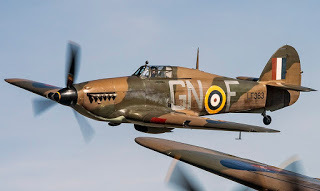
No.253 Squadron took off from Kenley to patrol over Canterbury at 15,000 feet to meet an incoming German raid. The commander, Myles Duke-Woolley decided on his own initiative to climb up to 28,000 feet as some recent German raids had come in at a greater height than the radar had estimated. A few minutes later the Big Wing approached from the north at 20,000 feet. They were heading due south to intercept a different German raid crossing the coast near Folkestone. Since the Canterbury raid had not materialised, Duke-Woolley decided to follow the Big Wing to see what they were after. As the Hurricanes swung in behind and above the Big Wing, the 12 Group pilots spotted them for the first time. Thinking that the Hurricanes were Bf109s, the Big Wing began to circle so that the “enemy” could not get behind them. Puzzled, Duke-Woolley also began to circle on the assumption that the Big Wing commander was waiting for a German formation to arrive. After several minutes of this, the Big Wing began to run low on fuel, so it turned off north to return to base while No.253 Squadron, by now equally low on fuel, returned to Kenley.
The recriminations that followed saw Leigh-Mallory condemning the freelance movements of Park’s squadron, while Park denounced the Big Wing’s shortage of fuel caused by the time it took to form up before heading south. The men of No.253 naturally mocked the pilots of 12 Group for their inability to tell the difference between a Hurricane and a Bf109.

The Great Persecution of Christians Begins
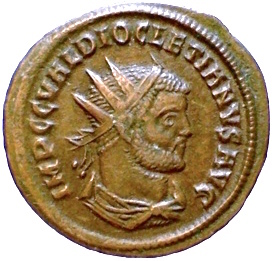 Bronze coin of Diocletion
Bronze coin of Diocletion
The years leading up to the pontificate of Eusebius were troubled ones, both for the Church and for the Roman Empire. A long war with the Persian Empire in the east had bled the Roman state of both money and trained military manpower. As a result there had been a series of rebellions in Egypt, Britain and North Africa which had been put down only with difficulty. Even worse the barbarians of central Europe were raiding over the Danube in numbers, causing damage which not only brought vast human misery but further weakened the finances of the Empire.
The general decline was brought to an end by the energetic ruler Diocletian, who took power in 285 as a result of a military coup. For the next ten years Diocletion fought a series of military campaigns to secure the borders and overawe potential rebels. The then turned to reforming the internal administration of the Empire. Provincial boundaries were redrawn, powers shifted from senators elected for life to officials appointed to short term positions by the Emperor. Taxes were changed to reflect ability to pay and corruption rooted out wholesale.
Diocletian then turned to religion. He believed that it had been the abandonment of the traditional Roman gods - under whose watch the Empire had grown - that had led to the downturn in imperial fortunes. He frowned upon the worship of gods from Persia, discouraged rituals associated with gods from outside the empire and had a particular distaste for the worship of the Sun. Then in February 303 two things happened that were to have a terrible effect on the Christian Church and pave the way for the pontificate of Eusebius.
The first event came when Diocletian and his favoured successor Galerius went to consult the oracle of Apollo at Didyma, in what is now Turkey. Instead of answering the questions as would have been normal, the oracle replied that "The activies of the impious on Earth hinder the ability of Apollo to give advice." Such a thing had never happened before. Diocletian and Galerius stared at each other in confusion.
The second event took place at the main imperial palace at Nicomedia soon after Diocletian and Galerius returned there after their abortive visit to Didyma. A fire broke out and destroyed much of the palace, including Diocletian's favourite rooms.
Looking round for someone to blame, and who Apollo might have meant by "the impious", Galerius noticed that the Christians of Nicomedia had just finished building a lavish new church. Galerius concluded that the Christians had been to blame, not only for the fire and for angering Apollo, but also for the general decline in Imperial fortunes over the previous 50 years. By worshipping a non-Roman deity, the Christians had been to blame for angering the old pagan gods, who had then turned their faces away from Rome with catastrophic results. It is thought that at this date around 10% of the Empire's population was Christian.
A contemporary head of Diocletian, the Roman Emperor who launched a savage persecution of Christians the aftermath of which dominated the pontificate of Eusebius.
Diocletian was quickly convinced by Galerius and so launched his great persecution of the Christians. First to suffer were the Christians of Nicomedia. The new church was pulled down and stripped of its valuables. All Bibles and other scriptural books that could be found were burned and several clergy executed. As the persecution rippled out through the Empire the violence against Christians increased dramatically. Priests, bishops and other leaders were executed - the famous St George among them - while hefty fines were imposed on anyone who would not sacrifice to Apollo or Jupiter. Christians employed by the state in the army or as officials were forced to sacrifice, or lost their jobs.
The severity of the persecution varied considerably. In Britain the tough new regulations were hardly enforced and only four people appear to have been executed, including St Alban who had a town named after him. In Asia Minor, however, mobs of pagans were encouraged to attack Christians, loot and destroy their homes and churchs and murder at will. Across the Empire thousands suffered beatings and financial loss, hundreds were thrown into prison and large numbers executed - some by being thrown to the lions in what pagan Romans believed to be a particularly degrading death - though at least it was fairly quick compared to some other forms of execution used by the inventive Romans.

October 12, 2020
BOOK REVIEW - Archangel by Robert Harris
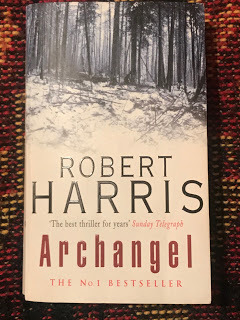
Yet another book set in Russia, what has got into me?
As you might expect from Harris, this is a solidly researched and gripping thriller. There is plenty of local colour - almost enough to make this useful as a travel book! The places that the action covers are beautifully described with bags of detail and background. The situation in Russia at the time this was written is well described. Even to the point of predicting the rise of a native hard man to power well before Putin came along.
The story line is good with plenty of twists and turns along the way. And the action is very much driven by the characters of the main players - which is not always the case with political thrillers. I particularly liked Mamantov, the old-style Communist hard man. A real thug, but astonishingly well drawn and his actions through the book, while apparently background, are driven by his character and as the plot unfolds turn out to be absolutely central to the final outcome. It must be said that the final few pages of the book came as a surprise to me, and I had been paying attention.
A great thriller.

October 5, 2020
BOOK REVIEW - Raputin's Shadow by Raymond Khoury
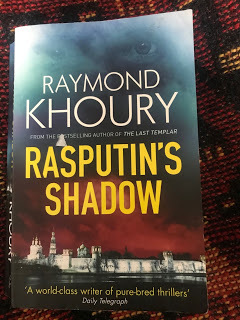
I quite enjoyed this book. It is a pacey little adventure thriller with twists and turns, good characters and exciting chases and intriguing puzzles. All very good. Mind you, the plot had a number of holes in it and a few non-sequiters. In part this might be because I have not read the previous books in the series, so what seemed to me to be an odd plot dead end might actually make total sense if you've read the series.
Anyway, the writer did a good job of making me care about the main characters. Even the villain was a great creation. In fact I felt quite sorry when he got his comeuppance, as I was rather wishing that he would escape and get away with his dastardly plotting. He should have been kept available to make a come back in a later novel in the series. Oh well.
My main complaint was about the Rasputin element. Every now and then we slipped off for a chapter or two taking place in the early 20th century. These were supposed to be giving us helpful background information on the mysterious MacGuffin, but in fact is rather unnecessary as the fugitive scientist does a pretty good job of describing it towards the end of the book. I wonder if this book began as a straightforward thriller, but at some point somebody decided that it needed a mysterious historical element chucked in - and they hit upon the idea of Rasputin having used the MacGuffin a century before the current villain does so.
Never mind. Ignore the Rasputin stuff and this is a cracking adventure novel.

September 29, 2020
BOOK REVIEW - 41 Years in India by Frederick Roberts, 1st Earl Roberts of Kandahar
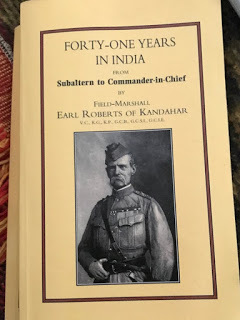
Fantastic!
This is the autobiography of "Bobs", as he was known, Frederick Roberts, the 1st Earl Roberts of Kandahar. I'd known of Bobs from other military books, but did not really know a huge amount about his life and career.
The book was written in the 1890s and clearly draws on diaries or letters written at the time. Nobody could have a good enough memory to produce this wealth of detail without such sources. The author seems also to have had access to government archives as he sometimtes quotes proclamations, letters and other official documents.
As with any book written so long ago, the author assumes that the reader knows all about things that were common knowledge in his day, but not now. So you will need to know the difference between a nabob and a nawab, a maharatta and a maharajah. Also, a map of India would come in very handy indeed. Plus a short guide to Prime Ministers and other leadering politicians of the 2nd half of the 19th century would come in useful. Plus, of course, he shares the views and opinions of men of his time - which may seem rather out of date today.
That said, this is a fascinating book. For a start it is a gripping tale of high drama, military escapades and political intrigues. Event follows event, drama follows drama with breathtaking speed. He skips often long periods of time with some quite short sentences along the lines of "I spent the next three years in garrison duty, but then was sent to command..." Great. No let up in the frenetic pace of action.
He arrived in India just before the Indian Mutiny, so a lot of the first part of the book is all about that upheaval. He covers a lot of ground that is familiar to historians - the chapattis, Mangal Pandey, Meeerut, Cawnpore etc - but most of it is composed of his personal adventures and his own observations on the causes and course of the great rebellion. All very interesting.
The book is filled with a huge variety of anecdotes and human-interest stories - albeit of a robustly male kind. The old man carrying a sword who Bobs saw by the side of the road as he was leading a column up to Afghanistan. He turned out to be a retired soldier who wanted to rejoin now his regiment was marching to war. How a mountain gun could be taken apart and carried on mules. The touchiness of officials from the independent states over official gifts, and the difficult matters of precedence about who sits where at a dinner.
The book is a real treasure trove of information about India in the later 19th century. Religion, food, social castes, industry, agriculture are all here, so are social mores and customs.
He also gives a lot of insights into how India has changed from when he was first there [the 1850s and 1860s] compared to "today" [the 1890s]. This usually revolves around transport and medicine.
If you see this book, grab it with both hands.
And read it!

September 28, 2020
BOOK REVIEW - The Centurions by Damion Hunter

A great book. This is a cracking adventure novel set in Ancient Rome and on the German frontier. There are battles, political intrigue, personal feuds, love interest and enigmas aplenty. If you like a good adventure, this is for you.
At first I worried that the central plot line would come across as artificial and silly. A pair of half-brothers - one a wealthy nobleman and the other the bastard sone of a slave woman - had the potential to be schmaltzy. In the event, the author carried it off very well. The way in which the kinship came about, the way the brother grew up and the method the father found to seek reconciliation were all perfectly credible and believable.
The secondary characters were all well drawn. The German leader is a great character with loads of potential, much of which was fulfilled in this book. The German slave woman was particularly credible with all her hang-ups and character flaws. Even the nomadic trader who was in the book for only a couple of chapters was well drawn with a good back story. In fact, I can't think of a single character who was not utterly credible and well drawn.
The story line was pretty good too. I won't give anything away, but there are twists and turns right up until the final page. And while this story is complete in itself, it sets things up nicely for the next book in the trilogy without leaving so many loose ends that it becomes annoying.

September 1, 2020
BOOK REVIEW - "Trilby" by George du Maurier

I found this to be a very odd book. I enjoyed it, but in places it did rather lose me. If it were not for the fact that it was so well known, and by du Maurier the elder I'm not sure if I would have stuck with it. As it is, I'm glad that I did and would urge you to make the effort to read this book.
It is very much a book in two halves, separated by some 6 or 8 years. The first half is primarily about three young British artists living in Paris in the 1850s. One of them - Little Billee - is phenomenally talented. A second, Taffy, is competent. The third, McAllister, is hopeless and sells few paintings, but as he is rich that does not matter. They share a large studio which is the centre of the social life for themselves and an assortment of neighbours and hangers-on who gather there to lunch, dine, chat, drink and generally pass the time of day.
It must be said that in this first half of the book - around 150 pages in my edition - not much happens. We meet a wonderful array of beautifully described characters. Among these is Trilby, of the book's title. She is a Franco-Irish model who poses for the three artists, and others. Rather amusingly when we first meet her it is when she comes along to pose her feet for a painting, and the novel spends over 2 pages describing her feet before we learn anything else about her. Also among the character is Svengali, a rather sinister chap. Of course, I had heard of Svengali and his evil powers, but in this first half there is littlesign of that. He is a somewhat slinky and unsavoury character but no hints of what is to come.
There are also soldiers, cooks, laundresses, musicians, bakers, cleaners and a host of others. This section also gives some wonderful descriptions of the city of Paris and life within it during the 1850s. Though, as I say, not much happens. And everyone is happy.
The second half of the book is very different. The three artists split up to go off and do other projects, then come back to Paris a few years later on a sort of vacation. This is when things start to happen. I won't give anything away, but this is a very much darker Paris. The old city is being swept away to make way for boulevards and the bourgeoisie. The generally working class characters from the first part, successively die or fall on hard times. Trilby becomes very much more the focus of the tale, and her story becomes increasingly tragic and melancholy as her involvement with Svengali increases. By the time we get to the end of the book nearly everyone is either ruined or dead. Though one character remains happy and prosperous.
It is well worth a read and is beautifully written. Enjoy.
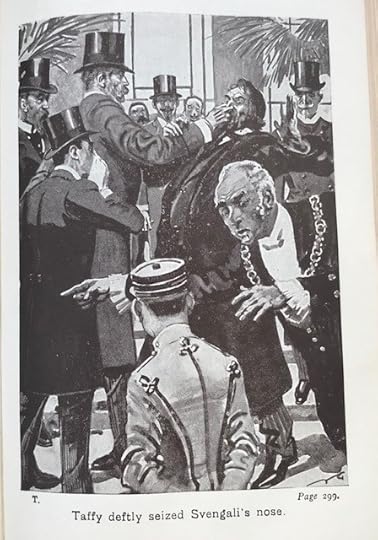



The Danish Armed Forces of 1940
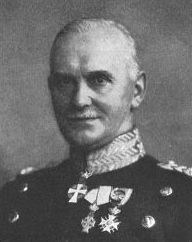
General Pryor commanded the Danish forces in 1940.
Although Denmark was at peace in 1940, the outbreak of war in Europe did have some effect on the military state of the nation. The professional army of some 7,000 men was supplemented by another 7,000 conscripts, and they were now put through rather more in the way of military training than was normal. The units were also dispersed to locations where they might be of use should an invasion take place.
The army was organised into two divisions. The First or Zealand Division was located on the island of Zealand, mostly in or around Copenhagen. It consisted of the Royal Life GuardInfantry Regiment, the Guards Hussar Cavalry Regiment, the 1st, 4th and 5th Infantry Regiments and the 1st and 2nd Field Artillery Regiments. The 2nd or Jutland Division was based on Jutland and comprised the Jutland Dragoon Cavalry Regiment, the 2nd, 3rd, 6th and 7th Infantry Regiments and the 3rd Artillery Regiment. The Danes had no tanks and no heavy artillery.
The Danish air force consisted mostly of patrol and reconnaissance aircraft, but there were also 8 bombers, 2 torpedo bombers and 15 fighters. The entire air force was based at Vaerolose near Copenhagen. Pryor had given orders that the air force was to disperse so that the aircraft were scattered between four different airfields. Ironically the date on which the move was scheduled to take place was 9 April.
The Danish navy was under the command of Admiral Aage Vedel, born in 1894, and had nearly a hundred vessels. Most of these were small boats tasked with patrolling fishing grounds, but there were a few larger vessels such as minesweepers and torpedo boats. A handful of destroyers and cruisers of antique vintage also existed, but they were hopelessly obsolete.

A Gloster Gauntlet fighter. Most of the fighters in the Danish Air Force were Gauntlets. With a top speed of 230mph and an armament of two 0.303 machine guns these aircraft were hopelessly outclassed by those of the Luftwaffe.




